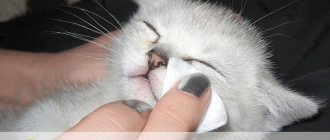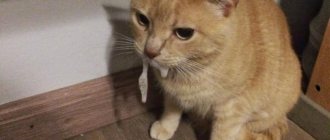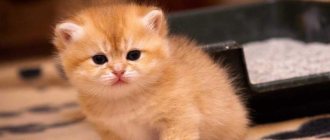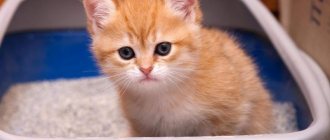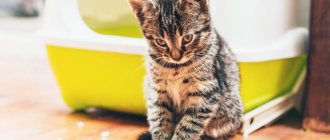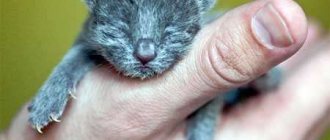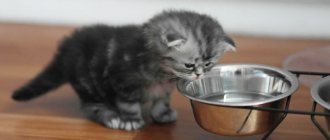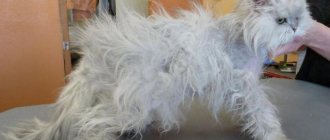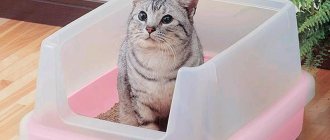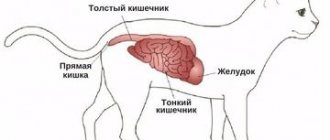Why do kittens have an enlarged belly, and what can we do to bring the animals’ digestive tract back to normal?
You've taken a mischievous furry creature into your home and can't get enough of its playfulness. In an effort to make the kitten grow up as quickly as possible, you probably think that he needs to eat more and start feeding him the same thing that you eat yourself. A large belly can paralyze the kitten’s digestive tract.
True, a big belly does not only arise from poor nutrition. The consequences of such a condition can be dangerous. Let's see why kittens have an enlarged belly and what we can do to bring the animals' digestive tract back to normal.
The concept of vomiting, its main causes
When harmful substances enter the stomach, the abdominal muscles and diaphragm begin to contract strongly due to the pressure of the abdominal cavity, which leads to the contents being pushed out. As a result, the kitten vomits. The question arises, what to do if a kitten vomits?
Black kitten
A similar situation happens with pets and does not always indicate serious illness. There are many reasons for this malaise:
- penetration of foreign objects, including grass or wool;
- overeating or prolonged fasting;
- quickly swallowing food;
- development of cancer diseases;
- inflammatory processes in the esophagus or throat;
- worms;
- reaction to taking medications;
- exacerbation of gastrointestinal diseases.
Also, the reasons why a kitten vomits may be kesosis or uremia.
Reference! If the spasm is an isolated and spontaneous case, there is no need to worry. Perhaps the animal swallowed its own fur or ate more than the prescribed portion.
You need to be wary if the urge to vomit is prolonged and occurs constantly. Then it is better to consult a veterinarian for advice.
Diagnosis and treatment
A consultation with a veterinarian begins with a medical history. The doctor asks about the pet’s diet, the time of onset of symptoms, and the presence of chronic diseases or infections. A visual examination, palpation of the abdomen and information received from the cat's owner are necessary to make a preliminary diagnosis. Its confirmation is carried out using laboratory diagnostic examination:
- blood, urine, vomit tests;
- Ultrasound of the abdominal organs and kidneys.
After the final diagnosis is made, the sick cat is prescribed a specific therapy regimen. This includes taking medications and restoring lost fluid.
Possible reasons
Only a specialist can determine the cause of vomiting in a kitten with scientific accuracy. But in some cases it is permissible to wait to contact him; An unpleasant phenomenon may have quite trivial reasons.
© shutterstock
Vomiting in a small kitten
If a small cat lives with a mother cat and feeds on her milk, there are few reasons for vomiting, but they are quite serious. Vomiting can occur if the cat itself has eaten something inappropriate or poisonous, with congenital pathologies, and with drug treatment of the cat.
When a very small animal begins to feel sick, it is better to consult a veterinarian - babies are very weak, and any illness is difficult to bear. It is also better not to treat a nursing cat with medications unless absolutely necessary.
Vomiting in a kitten older than 1.5 months
At this age, animals are usually transferred to permanent owners, taken away from the cat. If vomiting occurs during this period or later, there may be several reasons :
- stress (a kitten is the same as a child, and children often feel sick from fear or fatigue);
- sudden change of food;
- overeating (the new owners feed the furry “acquisition” with goodies);
- inappropriate food (the kitten should not eat fatty, salty, smoked or fried foods);
- poisoning;
- accumulation of hairballs in the stomach (typical of long-haired breeds, as well as British and Russian blue cats, which are fluffy in childhood);
- parasite infection;
- infection;
- disturbances in liver function;
- stomach diseases;
- foreign objects entering the stomach or esophagus (a kitten can easily eat a piece of paper, a piece of polyethylene or something similar).
You can understand the reason by the kitten’s behavior and the nature of vomiting. Depending on the findings, you should either do something yourself or quickly call a veterinarian.
Causes of vomiting
If a cat starts vomiting, then first of all the owner needs to calm down and not show fear prematurely. The thing is that very often vomiting acts as a protective reflex of the body. For example, if a cat vomits in the morning, then most likely it is caused by simple hunger. If this is the case, then as soon as he eats, his nausea will immediately go away.
Another cause of vomiting can be overeating. But this only happens when the owner does not monitor the diet.
© shutterstock
But, of course, nausea can also signal serious problems. The presence of parasites can cause vomiting. Two symptoms, the cat is vomiting and diarrhea, this is a signal that it has been poisoned by bad food.
Possible illnesses: additional symptoms of vomiting
When a kitten vomits, this process may be accompanied by other symptoms. Their presence or absence allows us to more accurately understand what is happening to the animal. Additional symptoms worth noting include:
- diarrhea;
- lethargic, depressed state, increased anxiety;
- refusal of water and food;
- sometimes there is increased thirst;
- active salivation and lacrimation.
Why does a kitten's whiskers break: the main reasons and what to do
The kitten is vomiting due to overeating
When a kitten vomits, you should pay attention to the consistency and color of the vomit.
Vomiting foam in a kitten
Many pet owners get scared when they see white, foamy vomit. There are reasons to be wary. Such vomit occurs due to overeating and disrupted diet. Spasms in the form of white foam appear due to accidental ingestion of fur or drug poisoning. Also, such a symptom often signals the presence of a serious disease, an inflammatory process in the gastrointestinal tract.
Important! Due to the wide variety of reasons, from harmless to very serious, it is impossible to say exactly why the spasms appeared. Therefore, it is recommended to consult a veterinarian and examine the animal.
Yellow liquid
If yellow vomiting is observed in a kitten at 2 months, then more often this indicates the development of helminthiasis, disruption of the liver and gall bladder. Severe poisoning of the body, eating fatty foods in large quantities, or intoxication due to medications can provoke yellow vomit.
The kitten is vomiting blood
Blood spots in the vomit are a dangerous symptom. There is a high probability that the kitten has a serious gastrointestinal disease or is developing a severe infection. If the blood particles have a bright or pink tint, this indicates mechanical damage to the stomach or digestive system. If bloody vomiting is detected, you should immediately visit a veterinarian.
Transparent slime
The presence of mucus in the mass is not normal and often signals an exacerbation of gastritis or the development of a peptic ulcer. It is also recommended to pay attention to your pet's feces. If there is also mucus in it, then most likely the kitten has a helminthic infestation.
Self-diagnosis
The appearance of vomiting and the behavior of the kitten cannot make a final diagnosis, but the owner can assess the general condition of the animal and make a preliminary decision on its treatment. If something changes later, the decision may need to be revised.
© shutterstock
Encouraging signs
You don’t have to worry too much and limit yourself to home treatment if the following easily noticeable signs are observed:.
- The kitten vomited undigested or poorly digested food once - this happens from overeating.
- The kitten behaves actively, does not refuse water and food, and no additional symptoms are observed.
- It was possible to see fur in the vomit.
- The kitten recently arrived in the house and vomiting is not accompanied by a refusal of water, convulsions, or an increase in temperature - most likely, the unusual diet is to blame. It’s worth analyzing it and asking the cat’s owner what kind of food the kitten previously needed.
It is almost certain that if such symptoms are present, the vomiting will stop quickly and there will be no consequences. If the symptoms persist, the help of a veterinarian will still be required.
Threatening symptoms
But there are signs when it is better to immediately seek advice from a specialist..
- A kitten vomits blood - a sign of mechanical damage to the esophagus or stomach or severe internal pathologies.
- Vomiting occurs repeatedly, and bile is present in the mass (it is yellow) - serious disturbances in the functioning of the liver and bile ducts are possible.
- There is white foam in the vomit - this may indicate infection.
- Worms were found in the mass - they should be removed immediately.
- Vomiting is accompanied by diarrhea - a sign of poisoning.
- A kitten refuses to eat and does not drink - a threat to life, whatever the reason.
- Vomiting is accompanied by convulsions, apathy, and fever.
Yes, kittens can vomit (just like children) for minor reasons, “in the mood.” But, if the owner notices at least some threatening signs, he should immediately begin to treat the animal, because otherwise it may be too late.
What types of vomiting are there?
- White foamy . There may be two reasons: 1) heavy, difficult to digest food; 2) diseases caused by infection.
- Yellow liquid . There is bile in the baby's ventricle. This indicates possible gastritis, colitis, and dysfunction of the bile ducts.
- Admixture of blood . Vomiting can be of a mechanical nature (due to injuries to the esophagus) or medical (neoplastic diseases, severe diseases of internal organs, etc.).
- With helminths . It means the body is heavily infested with parasites.
- Pieces of undigested food . A young patient may have an intolerance to certain types of foods that the stomach simply cannot digest.
Why is vomiting dangerous?
Vomiting blood in a cat: reasons, what to do
Many people wonder what to do if a kitten vomits. First of all, this should not be taken lightly. An isolated incident is not a reason to sound the alarm. But if the spasms are repeated, vomiting with blood or mucus, then you should seek help. After all, nausea is a dangerous process. If you start it, exhaustion will begin.
Lethargic pet
The kitten will not be able to eat or drink normally, and the disease that caused the spasms will begin to actively develop. Therefore, it is recommended to be attentive to your pet’s health and, if you have any doubts or warning signs, contact your veterinarian.
Caring for a kitten until recovery
In case of poisoning, overeating, food intolerance and other reasons that caused vomiting, the kitten must be closely monitored. You should create the most comfortable home environment for your pet so that he can quickly recover.
In the first hours when the animal vomits, you need to lay the pet on a soft bedding, hang its head slightly down and turn it on its side - the kitten may lose consciousness and choke on the vomit. In case of poisoning, give the animal a solution of Smecta or Enterosgel.
If vomiting is repeated, you should give your baby lightly salted water to avoid dehydration. You can prepare a chamomile decoction for your pet to strengthen the body and combat poor health.
When emergency help is needed
There are cases when consultation with a veterinarian is urgently required. For example, if an animal has frequent vomiting, and it does not stop even after the stomach is empty, the mass itself is copious.
Diarrhea and vomiting in a cat: what to do at home
The discharge contains impurities unusual for normal vomiting, including bloody inclusions. Also, for a long time, the kitten is lethargic, constantly sleeps, does not play, does not eat, and shows little interest in the world around it. Vomiting is accompanied by fever and high temperature. The pet may diarrhea. If the animal’s general condition rapidly deteriorates, you should visit a doctor immediately.
Reference! Due to their age, kittens are quite playful and curious. Therefore, it is easy to notice from them that they have become lethargic and less active. This is one of the main and first symptoms that should alert the owner.
Cat burps after eating: what to do
How to worm a cat at home
In some cases, nausea is an episodic phenomenon, and vomiting is a consequence of eating too much. Sometimes vomiting, once it starts, does not stop and even, on the contrary, becomes more frequent and transforms into a symptom of a serious illness. If this happens, only a specialist can understand what is happening to the animal.
Important! Almost always, vomiting in cats can be caused by the need to clear the stomach of hairballs that enter the animal's body during washing. Among the least common causes are ear diseases.
A cause for concern is refusal to eat due to vomiting or lack of appetite. The owner should take a closer look:
- how quickly the cat eats the contents of its bowl (if it eats anything at all);
- does the animal drink water?
- how the cat’s behavior and character have changed. For example, has she become restless, are her eyes watering, has her salivation increased, has insomnia appeared, is she wandering from corner to corner without a specific purpose, etc.
Some indoor cats like to chew on indoor plants, which, unfortunately, are more or less toxic.
What symptoms require you to contact a veterinarian?
The kitten should be shown to a veterinarian as soon as possible in the following cases:
- vomiting is profuse, repeated more than 3 times in a short period of time;
- there is blood, bile or foam in the vomit;
- the urge to vomit is painful;
- nausea is accompanied by other symptoms - convulsions, loss of consciousness, high body temperature.
If you suspect poisoning by poisons, chemicals or drugs, you cannot hesitate - every minute of inaction by the owner can cost the pet’s life. Based on the examination and collected medical history, as well as the results of laboratory and instrumental studies, the doctor makes a diagnosis and prescribes treatment. Depending on the situation, the patient may be prescribed antiemetic, antiviral, antibacterial and painkillers.
In what cases is it necessary to see a doctor?
Bile-colored vomit or watery vomit mixed with blood can be a harbinger of serious health problems. This is a fairly serious reason to contact a veterinarian.
You can find out exactly the cause of your pet's condition from your veterinarian.
What is intestinal obstruction
Often, while playing, animals swallow small toys, paper clips, erasers, etc. By clogging the intestinal lumen, swallowed objects prevent food from passing through the intestines. A sick pet experiences frequent vomiting and loses weight. Most owners start treating their pet for food poisoning instead of taking it for an x-ray.
Important! If you miss precious time, the foreign body can only be removed through surgery.
If vomiting begins suddenly, if it is severe and prolonged, such a situation can be called an emergency. The detection of blood or foreign objects in the vomit indicates the need to provide emergency assistance to the animal.
If the vomit looks like coffee grounds, this is also an emergency. Vomiting accompanied by changes in appetite, appearance, behavior, or habits may also indicate serious health problems.
Here's what not to do:
- ignore the animal's condition;
- dramatically change your diet;
- leave poisonous plants in areas that the cat has access to. The same rule applies to cleaning products and household chemicals;
- You should not leave small objects that are tempting for a cat (earrings, rings, hair ties, etc.) within the animal’s reach;
- You should not give your cat antiemetic medication without consulting your veterinarian.
Treatment at home: if there is no veterinarian
If it is not possible to visit a veterinarian, but the kitten vomited food, what should you do in such a situation? It is necessary to provide first aid to the animal, to alleviate its condition so that it stops burping. You should proceed like this:
- stop the penetration of toxic substances into the stomach. But only if the owner is sure that his pet was simply poisoned. In other cases, you should simply not allow the kitten to eat, so as not to worsen the situation;
- prevent dehydration of the body. This is a common negative consequence of nausea. For this reason, the animal must always have access to clean water. If he doesn’t want to drink himself, it is recommended to carefully water him with your own hands. This item is excluded if new vomiting occurs precisely because of water;
- When a pet swallows a foreign object and a mouth appears, it is necessary to empty the pet’s throat. If the owner is not confident in his own abilities, it is better to entrust the removal of the object to a professional, so as not to injure the kitten’s fragile body.
After first aid is provided, treatment begins. But this cannot be done without consulting a doctor. If the diagnosis is made incorrectly, the medications are chosen incorrectly, the animal will only get worse. Therefore, home treatment without consulting a veterinarian will only consist of establishing a diet.
Treatment
Treatment methods for vomiting are developed after identifying the causes of its occurrence. If a cat's vomiting is caused by overeating, we are talking about changing the diet or reducing portions.
Chronic vomiting of undigested food in a cat can be treated with diet. The veterinarian will prescribe boiled rice, carrots, cottage cheese, soft-boiled eggs and plenty of fluids.
If vomiting is profuse and occurs frequently, the veterinarian may prescribe intramuscular injections for the furry patient. For example, cerucal or no-shpu (0.1 ml of medicine per 1 kg of animal weight).
Important! When a cat vomits, the first thing the owner should do is limit the pet’s food for 5–8 hours. It is necessary to ensure that the animal always has fresh water, since during vomiting the body becomes dehydrated. Experts do not recommend forcing your cat to drink; he should do it himself.
When a cat vomits, he needs to be put on a diet
It is necessary to find out what temperature the animal suffering from vomiting has, and then examine its oral cavity for the presence of foreign bodies or scratches. If the owner is unable to independently identify the cause of the cat’s nausea, a trip to the doctor is mandatory.
Treatment methods
After establishing the reason why the kitten is vomiting, it is necessary to immediately begin treatment. In most cases it is possible at home, although in severe cases a clinical setting may be required.
© shutterstock
Simple Home Remedies
It is not difficult to treat a kitten for vomiting that began due to overeating or unusual food. The basic method is to put him on a fasting diet for a day or half a day (depending on age), giving him water, often, but little by little. If the vomiting stops, you can feed the kitten medicated food, rice water or lean meat, and then switch it to regular food.
If treated well, stress in animals goes away quickly. Usually within a few days they get used to the diet in a new place. To prevent vomiting from recurring, the owner must protect the animal from unhealthy and age-inappropriate food and feed it in small portions, several times a day.
Problems with hair in the stomach usually go away on their own. The kitten masters the “washing” technique and stops suffering from lumps.
Carrying out prevention
Prevention of sudden attacks of the gag reflex is carried out with the help of:
- regular anti-worm therapy. For cats walking outside every 3 months;
- annual vaccinations, preventive examinations at a veterinary clinic for timely detection of hidden diseases;
- proper nutrition. Balanced ready-made food in sufficient quantities will help avoid pathological conditions;
- pet care. Brushing will prevent the accumulation of hairballs in the stomach;
- maintaining hygiene in the home. A clean room and no small objects that the cat could swallow.
White foam along with the contents of the stomach can have both physiological and pathological origin. The appearance of accompanying clinical signs requires seeking professional help and undergoing a full diagnostic examination. Timely treatment will avoid complications and save the life of your pet.
Vomiting is considered a sign of a digestive system disorder, but in cats this process may be normal. In some cases, animals specifically eat grass. This triggers a gag reflex, which helps clear the stomach.
If your cat vomits white foam rarely, there is no need to worry. However, if this happens constantly, you should take your pet to the vet, as vomiting can be a symptom of a serious illness.
Dietary food for vomiting: the kitten has eaten too much, what to do?
Vomiting occurs when the kitten has eaten too much. Then it is necessary to establish its nutrition. Undigested food often causes cramps. For the first 10 hours the animal remains without food. This is a beneficial fast that allows you to calm down an irritated gastrointestinal tract. Water is not excluded from the diet at all. It is necessary to water the kitten. If he doesn't drink himself, the owner takes matters into his own hands. After some time, you can introduce milk.
Diet for vomiting
Avoid heavy, salty and spicy foods. If the main food is dry food, then for the duration of the diet it is better to purchase special medicinal types. You can add boiled chicken, boiled rice or baby food to your diet.
How to provide first aid to a kitten
If the manifestation of vomiting was isolated, the baby does not feel weak, his stool is not disturbed, the temperature is within the normal range, then most likely nothing serious has happened and you can help the patient yourself. The algorithm of actions in this case will be as follows:
- Give your pet a food fast for 12 hours. It is impossible to keep a small animal on a starvation diet for longer than this period.
- Give your baby clean water every 1.5-2 hours. If she refuses, then do it forcibly, using a syringe without a needle.
- Give a children's absorbent drug, for example, Smecta.
During the fasting diet, the pet should feel better. Then you can gradually introduce small portions of light food into the diet (white boiled chicken meat or broth, rice broth, medicinal ready-made food for kittens). After a couple of days, you can gradually switch to your usual menu, avoiding spicy and greasy foods. smoked or sweet foods.
Preventing vomiting in kittens
It is better to prevent any disease than to treat it. Therefore, it is recommended that kittens be vaccinated to prevent vomiting. This will prevent the development of various diseases. Also worm the animal regularly and ensure that its diet is balanced. You should not allow your pet to overeat. The kitten should always have plenty of water. You should also get a special paste for cats with long hair. It allows you to dissolve the hairs and prevent nausea.
Thus, vomiting in kittens is quite common. The problem may be caused by overeating, poor diet, or infection. In the latter case, the pet needs to be shown to a veterinarian.
Video
Vaccination of cats at home
The visiting veterinary service "Doctor-Vet" vaccinates cats at home. Recently, this service has been gaining popularity, since owners do not always have the opportunity to take their pet to a veterinary clinic. To do this, you need to set aside time, take the kitty to the doctor, and sometimes spend more than one hour waiting in line. Not everyone can afford such a luxury, because in modern conditions, wasting time waiting is truly a luxury.
For cats, vaccination at home also has significant advantages. After all, the animal is in a calm environment, does not experience stress and will tolerate the vaccination more easily. It is advisable to do the first vaccination for a kitten at home, since in a veterinary clinic contact with other animals is inevitable, and the kitten’s fragile immune system can easily catch any infection.
Vaccinating cats at home is no different from a similar procedure in a veterinary clinic. The veterinarian uses the same tools and medications.
It is important that your cat is vaccinated in a timely manner. There is a standard vaccination schedule that owners should follow. We looked at it here
Prices for cat vaccination in Rostov-on-Don
The price for vaccinating a cat depends on what kind of vaccination is being done, as well as on whether this is the first procedure for the animal or a repeat one. Prices in Rostov-on-Don for cat vaccination vary insignificantly. You can find prices for vaccinations at the Doctor-Vet veterinary service here.
If you have any questions about cat vaccination, call: 8 (863) 221-55-81, 8-903-485-99-81! We will be happy to answer any of your questions!
Remember that timely vaccination is a reliable investment in the future health of the cat, because young cats and kittens are very sensitive and vulnerable to various types of infections.
Most animals on our planet have an innate function called vomiting. This function serves as a complexly coordinated digestive defense system. Most often it is caused by various irritants of the gastric system, substances used artificially - for example, medications. Vomiting in a kitten can be caused by any of the senses of a living creature - eyes, smell, taste stimuli, touch, as well as when the load on the vestibular apparatus increases, which in turn increases intracranial pressure.
Cat vomits after a big lunch
Neutered cats often overeat their quota.
If the trouble occurred after a hearty lunch, and it excludes any toxic substance or foreign body from entering the body, it is enough to carefully observe the cat during the day.
This reaction of the cat’s body is considered acceptable and is associated with the functioning of the digestive system.
The cat digests the food it eats within eight hours, and if vomiting occurs during this period, you can notice a small bolus of food mixed with bile. If the cat was bothered by vomiting on an empty stomach, then the vomit will be one thick mucus streaked with bile.
This situation poses a great danger to the health of the animal.
Why does a cat vomit after eating?
The most common causes of vomiting and diarrhea in cats are poisoning, liver and kidney diseases. It is likely that nausea may be a symptom of pancreatitis, gastritis (chronic), tumors in the gastrointestinal tract, infectious disease, peritonitis, colitis, problems with the colon, intestinal obstruction or uremia.
For your information! If the cat is pregnant and vomiting begins in the third month, this is a sign of toxicosis. The gag reflex may be a manifestation of hormonal changes or indicate imperfection of the vestibular apparatus.
Types of vomiting
Vomiting in the form of white foam usually occurs on an empty stomach and does not threaten the cat in any way.
If a cat vomits after eating, and the vomit with or without foam is green, this is abnormal, because there should be no bile in the stomach. Even if bilious vomiting occurs once, this is a signal of problems with the liver, gall bladder, or intestinal obstruction. Green vomit is a good reason to visit the veterinarian.
Vomiting blood is not always a cause for panic. First, you should examine the animal's oral cavity. Perhaps blood is oozing from wounds or scratches on the cat's throat or palate caused by playing or eating. There's nothing wrong with that. But if there are no wounds, and the blood is thick and dark, this indicates a serious disease of the gastrointestinal tract and is a reason to visit a veterinary hospital.
Important! If frequent bouts of vomiting torment a kitten, the owner should take a closer look at the pet. After eating, kittens usually burp. But if belching appears not only after eating, but food particles come out along with gases, this is bad. What exactly happened to the baby will become clear only after he is examined by a specialist.
The following symptoms are a reason to immediately contact a veterinarian:
- vomiting does not stop for several days;
- the cat vomits more than twice daily;
- vomit is a mixture of blood, bile, yellow mucus, hair and fluids of unknown origin that are not related to the animal’s diet;
- vomiting begins immediately after eating or regardless of food intake.
The veterinarian needs to analyze the vomit to make a diagnosis.
In most cases, the cause of vomiting is an imperfect menu developed by an inexperienced breeder. Below is an approximate portion of a cat's diet:
- a little lean beef or beef liver (25 g and 10 g respectively);
- steamed fish or a piece of raw lung (25 g and 5 g respectively);
- chopped raw or boiled carrots (25 g);
- rice porridge (about 20 g);
- vegetable oil (no more than 2 g);
- cottage cheese (3 g each).
- water.
For your information! A stud cat needs a plentiful and nutritious diet. Breeders try to feed their pets lean pork (the daily diet of an ordinary cat includes about 20 g), raw pig kidneys (no more than 10 g), boiled rice (about 4 g per day), flavored with vegetable oils (no more than 0.2 g) . If your cat vomits after eating undigested food, the cause may be an intolerance to raw meat or other foods.
Many cat lovers are sure that the diets of the ancestor of purebred individuals should contain dry yeast, chicken meat and vitamin E. According to veterinarians, chicken should be excluded from cat food forever, regardless of the age, gender and health status of the animal. The cat may vomit from the toxins.
The food may simply not be suitable for the cat.
Chicken meat may contain hormones that end up in the bird's stomach along with the feed. For this reason, chicken is not recommended for pregnant cats. The menu of a future mother cat or nursing individual should be developed in such a way that only energy foods enter the animal’s body: fish, liver, fresh herbs.
Important! A bowl of fresh and clean water should be available to pets at any time of the day.
Reasons why a cat vomits white foam
LIFE HACK: There are special tablets and pastes that help in this process.
Often, dry food is not digested in the stomach, but swells. This leads to the same process as in the case of overeating - the stomach throws out the excess.
While playing, our pets can put completely inappropriate things into their mouths and swallow them. This is good if the object is small and safe - the cat will deal with the problem itself. Otherwise, you need to go to the doctor.
During the period when cats are trying to find a partner, they behave differently (3-4 times a year). In rare cases, this event may be accompanied by nausea and white foam. Also, cats, like pregnant women, experience toxicosis. Moreover, not only at the beginning of pregnancy, but also later. This is due, first of all, to changes in hormonal levels.
For the most part, it is normal if an animal begins to vomit after taking medications (antibiotics, anthelmintics). Also, a cat may vomit white foam after castration or sterilization. You should be concerned if this process is prolonged and your pet begins to feel unwell.
The causes of natural vomiting, about which you should not worry, were discussed above. At the same time, veterinarians say that some diseases can be identified by the color/amount of vomit.
When vomiting bile is not dangerous
If during the molting period you notice that your cat is vomiting, then you need to brush it more often.
There are quite “real life” situations when the appearance of vomiting with bile is normal, and the owners have nothing to worry about:
- For cats, a natural behavioral response is to groom their fur with their tongue. It is not surprising that over time a fair amount of hair . To get rid of it, the body provokes a gag reflex.
- Sometimes a similar reaction occurs in animals after undergoing surgery , in particular after sterilization.
- Feed the cat once a day , and very generously, with dry food. A very common situation is when owners are at work all day and cannot feed the cat more often, but in smaller portions. Special automatic feeders will help save the situation, which would “give out” additional food to the pet 1-2 times between the main feedings in the morning and evening.
Feed your cat more often, but less food
Try to feed your cat more often, but in a balanced manner. There is no need to fill the bowl with a heap. Neutered cats may overeat.
In this case, it is important not to forget the basic rule - the more often the cat receives food, the less amount should be eaten at one time. As a compromise, food specifically designed for single feeding of cats is also suitable.
Their composition is not only balanced in all important components, but also contains a lot of dietary fiber.
Diagnostics
When contacting a veterinary clinic, you need to provide the specialist with the following information:
- What did the cat feed, were there any changes in the diet.
- How often did vomiting occur?
- Are there any chronic diseases or infections in the animal that the owner is aware of?
This will help establish an accurate diagnosis and take the necessary measures.
Diagnosis of the pathological condition of a cat is as follows:
- analysis of the type and consistency of vomit;
- examination of the cat, analysis of the general condition;
- laboratory tests of blood, urine;
- Ultrasound of the abdominal cavity, kidneys.
The treatment regimen is selected depending on the established diagnosis. It includes drug therapy and measures to prevent dehydration.
During the treatment of vomiting in a cat, a special diet is necessary. Food should be semi-liquid. Feed your pet more often, in small portions. Meat should only be given boiled and chopped. After stabilization of the condition, the transition to the usual diet should be gradual.
